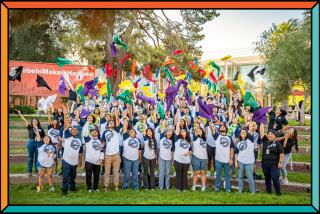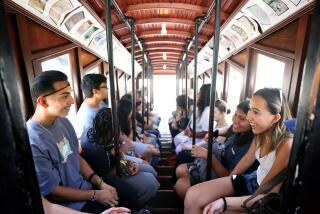Friends for Life
- Share via
If the current craze for mentoring seems surrounded by a warm and fuzzy glow, it’s due to stories like that of Billy Hall and Tyrell Smith.
When they met two years ago through a workplace mentoring program at 20th Century Fox, the two barely spoke. Hall, a suit-and-tie family man from suburban Valencia, had built a successful career in the Dream Factory as a programming director for FX Networks. Tyrell was a sneakers-and-pierced-ear sophomore at Dorsey High School, in a neighborhood where dreams materialize with great effort.
An African American who had succeeded in the mostly white corporate world, Hall had volunteered because he wanted to be a role model. He hoped to show Tyrell, an African American being raised by a single mother, what minorities can accomplish with education, hard work, self-made contacts and focus.
Along with a group of about four dozen mentors and students, they met at Fox for programs and seminars two hours every other Thursday for two years. Tyrell’s shyness melted after three weeks and the two became buddies, with Hall taking him on outings and showing him the tangible fruits of a regular and sizable paycheck.
Now about to graduate, Tyrell says he wants what Hall has and that his mentor gave him the “extra push” to go for it. This June, he will be among the 27% of students who graduate from Dorsey. He plans to go to Santa Monica College. He wants to be a cameraman. And, ultimately, he says, “When I’m out in the working field and doing what I want to do, I too will become a mentor and repeat the cycle.”
Often held up as a miraculous, personally satisfying and cheap means of solving the nation’s major social problems, mentoring received the equivalent of a standing ovation at last month’s Presidents’ Summit for America’s Future in Philadelphia. Organizations nationwide pledged to recruit 2 million mentors by 2000. President Clinton said he aims for “an ongoing relationship with a caring adult or mentor” for every at-risk child in the country. In California, where $12 million has been allocated and another $21 million proposed to support local efforts, even the governor has found himself a “mentee”--a teenage boy who lives in the capital.
Research shows that certain one-on-one mentoring can make a dramatic and positive, if short-term, difference in the lives of disadvantaged youths. The benefits are even stronger, researchers say, when the one-to-one relationships are strung together with others to create a “caring climate,” or a web of support through schools and youth organizations.
At the same time, the mentoring movement has had a checkered history of disappointments, frustrations and resentments. Mentors don’t always show up; mentees aren’t always magically transformed. Race can be an issue in the matches. Boundaries blur and trust can be threatened if a mentor stumbles upon an illegal activity or if a mentee’s family asks for money.
The screening process alone, which opens volunteers’ eyes to the reality, can be daunting. Only 15% of applicants survive to volunteer with Big Brothers, the nation’s oldest mentoring organization.
Even supporters say it is foolish to hang hopes for massive social change on the most delicate of social forms: human relationships. “There is so much opportunity for hurt,” said Marc Freedman, vice president of the Philadelphia-based Public / Private Ventures and author of the definitive book on the movement, “The Kindness of Strangers” (Jossey-Bass, 1993). More than instances of abuse, which are rare, he said, “There can be subtle and long-lasting damage if an adult comes in and imparts a destructive message about what their limitations are.”
More than a century ago, a similar movement aimed to help the poor with “friendly visitors,” middle-class women who tried to establish relationships with and serve as models for immigrants in urban slums. The movement began to fall apart when the genteel volunteers, sometimes perceived as patronizing, found people preferred to seek help from their friends and neighbors. A series of economic depressions finally “put the power of middle-class friendship in perspective,” and friendly visiting gave way to the social work profession, Freedman wrote.
The subsequent success of Big Brothers / Big Sisters, first formed in 1921 to pair fatherless children with adult volunteers in long-term commitments, produced another wave of mentoring and many stories of lives changed because of “one caring adult.” A third wave has been building over the last decade. In addition to Big Brothers / Big Sisters, there are now at least 280 mentoring programs providing 80,000 matches in California alone. State officials say there are 70,000 more youths on waiting lists.
*
Until recently, however, researchers were not sure whether the stories of inspiring turnarounds were due to the efforts of a particular neighbor, coach, teacher or minister, or whether it was the youths’ own internal qualities that propelled them to seek and attract mentors. Then in 1992, a study of Big Brothers / Big Sisters by Public / Private Ventures found dramatic results about mentoring.
The study focused on 1,000 students 10 to 16 who had applied and were on a waiting list for mentors. Eighty percent were from impoverished families; nearly all were being raised by a single parent. Half were matched with a mentor, while the rest remained on the waiting list.
After 18 months, the number of mentored students who initiated drug use was 47% lower, truancy was down 52% and violent behavior was 33% less. The youths with mentors were more likely to do well in school and got along better with their mothers.
The study also discovered that the most successful mentors showed up consistently 10 to 14 hours a month with the intent of having fun and making friends. The volunteers who came armed with a social agenda “to make a difference” had no effect, Freedman said. “You don’t have to be a charismatic superhero to make a difference,” he said. “Just show up and like kids.”
Freedman cautioned that the new fervor for mentoring must be accompanied by careful screening, training and--most important--a genuine commitment of time. “It’s almost as if mentoring were built on this paradox,” he said. “On the one hand, everyone agrees adults don’t spend enough time with kids. On the other hand, adults don’t have enough time to spend with their own kids. They find out all too often, they don’t have the hours to do what’s really required.”
An often overlooked solution lies with retirees, a group that will be expanding as baby boomers age, he said.
Skeptics variously decried the Philadelphia Summit as feel-good boosterism, a smoke screen for declining government social supports or an arrogant assumption that a personal relationship with a middle-class person is more valuable than financial assistance. But the promise of mentoring taps a deep root of what Freedman calls a “quintessentially American outlook: optimistic, individualistic, anti-institutional, anchored in the belief that we can reinvent ourselves and overcome the odds, no matter how daunting.”
Believers see in the new enthusiasm an urgently needed opportunity. They say they can avoid pitfalls of the past with a variety of new approaches. Gaining particular attention are workplace mentoring programs, like the one at Fox, which combine the benefits of a caring adult with the need to create marketable job skills for youth.
Advocates said that meeting at the work site attracts time-strapped mentors, because they don’t have to travel long distances in their off hours. Larger groups provide a pool of people from which to form backup matches. Exposing youths to friends in the work world offers a more positive approach than programs that “prevent” crime, teen pregnancy or drug abuse.
“We want hundreds of businesses, large and small, involved in structured, long-term workplace mentoring programs,” said Patrice Theard Lombard, executive director of California One to One, a nonprofit organization formed in 1990 to help guide mentoring groups. Now, there are only about 10 in Los Angeles County.
*
Far from the hoopla of Philadelphia, Principal Nancy M. Rene leaned across her desk in a cheerful office at Dorsey High School in Los Angeles and considered her biggest challenge: helping students see the connection between education and life.
While adolescents everywhere have trouble visualizing the future, she said, “It’s more difficult if you think the American dream doesn’t apply to you. You have to show them by example that it really does.”
Outside her window, the neighborhood sparkles with many well kept homes, but the picture is deceptive. Rene said those parents tend to opt for open enrollment and send their children to schools on the Westside or the Valley. Of those who remain, many are growing up in “no-parent” households--headed by grandparents, aunts, foster parents--or in group homes. Virtually the entire student body is African American or Latino; many of the students’ parents never graduated from high school. Seventy percent of the students are eligible for free government lunches.
And this is crucial: Those students tend to stay in the neighborhood. “Our children in the inner city rarely go downtown, to the art museum, the Music Center or the beach,” she said, sometimes because they feel they don’t belong, sometimes out of fear they may be trespassing on a rival gang’s turf. “They go to the mall or the Magic Johnson Theatres. That’s about it.”
Rene applauds the surge in volunteering and wishes only that there were more companies offering mentoring programs like the one at Fox, the only one of its kind on campus. “We could have half the student body involved in these things,” she said. “They could begin to feel they’re a part of the whole scene in L.A.”
Known to school officials as the most intensive workplace mentoring program in Los Angeles, the STAR (Success Through Achievement & Responsibility) program is run by Fox employees with financial support from management ($20,000 to $50,000 a year).
Recruited by e-mail, the volunteers had to take a tuberculosis test, were screened for criminal records and were trained for three to four hours in child development and mentor do’s and don’ts (“Don’t make a commitment unless you can follow through”). Students, referred by teachers and counselors, also filled out forms with their likes and dislikes and favorite classes. Matches were made based on mutual interests.
Every other Thursday during the school year, Fox buses the students to its studio in Beverly Hills, where they meet their mentors for lunch in the commissary, followed by a two-hour session that includes seminars on career or health topics, one-on-one time with the individual’s mentor to talk over academic or personal issues, or a job shadowing session to observe various occupations. Students are also eligible for paid summer internships and can compete for scholarships.
Mentors have had to explain that dressing for work means no fancy jewelry. Some have taught their charges telephone manners.
After spending his junior year in the program, Tyrell Smith impressed his friends by getting a summer internship watching competitors’ TV shows and reporting on how they promoted their fall lineup. “They didn’t believe me at first,” he said. He made only $4.25 an hour, but that was cool. “It was the experience,” he said. “Everybody was all happy for me. My friends said, ‘My boy big time now!’ ”
School district officials discourage the workplace mentors and mentees from meeting outside work; if there is any problem, the company could be liable.
Indeed, Big Brothers of Greater Los Angeles forbids volunteer mentors at its one workplace site to meet with the youths outside the workplace. “For us, it’s a scary thing to see other mentor programs popping up and not understanding what you need to do to secure the safety of children,” said Nancy Rose Dufford, director of public relations for the organization, which spends between $2,000 and $2,500 on making each match. “Not to say we can’t trust anybody. Most people are doing it with their heart in the right place. But you can’t go into it blindly either.” As always, she said, “Mothers need to stay on top of any relationship.”
But some mentors and mentees ignore the advice, meeting at each other’s homes or for special outings. Hall said that as part of his friendship with Tyrell, he has taken him to Magic Mountain and gave him a tour of his new house before he bought it. He also visited Tyrell at his workplace, a camera store.
As their friendship bloomed, they joked, had fun and talked over serious, personal issues. Hall talked about the importance of family and called with the news of his daughter’s birth, explaining that he wanted to set a good example personally as well as professionally.
After two years, he said the boy has become such a part of his life that he’ll miss him when the official program ends. He hopes they keep in touch.
*
Some workplace mentors believe their role is to support both the school and the parents--who often find it impossible to communicate with their teenagers just at the time teens need guidance most.
“In high school, you can talk to your parents, but only so much,” said Gayle Robinson, an assistant for in-theater marketing at Fox. When you’re a teenager, she said, “You look at your parents and they look really old. They don’t know how it is these days.”
Some students have complained that the matches were not made with someone of the same race or gender. In those cases, the school counselor explained to the students that, “We have only so many volunteers, and they need to understand, this is life,” said Deborah Bryant, STAR program chairwoman and director of royalties reporting for Fox Home Entertainment.
Freedman said his study found that although race did not affect outcomes, it still mattered. In general, there was a greater commitment on the part of mentors to mentees of the same background. “They felt a special stake in the future well-being of the child,” he said. On the other hand, in mixed-race matches, both received the benefit of being exposed to a different culture.
Andy Mendoza, a junior, said he was surprised that he and Hector Franco, another junior, were matched with Linda McDonough, 25, a writer’s assistant. “Usually, you get a male mentor, but that’s OK,” he said brightly. “She’s interested in us; she cares about us. She’s always asking, ‘What are your projects? Can I help you?’ She’s always after us.”
On their last day together before the summer, McDonough introduced the boys to writers of “The X-Files” before heading toward her cramped office, where they reviewed research for the boys’ paper on minorities in the media that might qualify them for the Fox scholarship.
Occasionally, mentors have become frustrated with turnover and outside forces that impinge on their new relationship.
One mentor at a similar program at another company learned that his middle school student’s parents were dealing drugs. He knew from his training that he was supposed to report dangerous situations to the school, and after some soul-searching he did. An uproar ensued, but he and the mentee were able to restore their sense of trust.
At Fox, one student dropped out suddenly when family turmoil forced him to move out of state. Two washed out for failing to maintain the required 2.0 grade-point average to stay in the program. One disappeared when she ran away from home.
Together for their last official lunch in the bustling Fox commissary, Hall and Tyrell greeted each other like fond brothers, teasing each other about the fate of the other’s favorite basketball team.
Tyrell said he never really felt the need for a mentor. He already had a career goal when he entered the program. He gets support from his mother and other relatives. He has a relationship with his father.
But he always looked forward to every other Thursday, he said, glancing sideways at Hall. “Just coming here and being with him.”
Then it was Hall’s turn to be shy. “Aw, man.”
More to Read
Sign up for Essential California
The most important California stories and recommendations in your inbox every morning.
You may occasionally receive promotional content from the Los Angeles Times.










